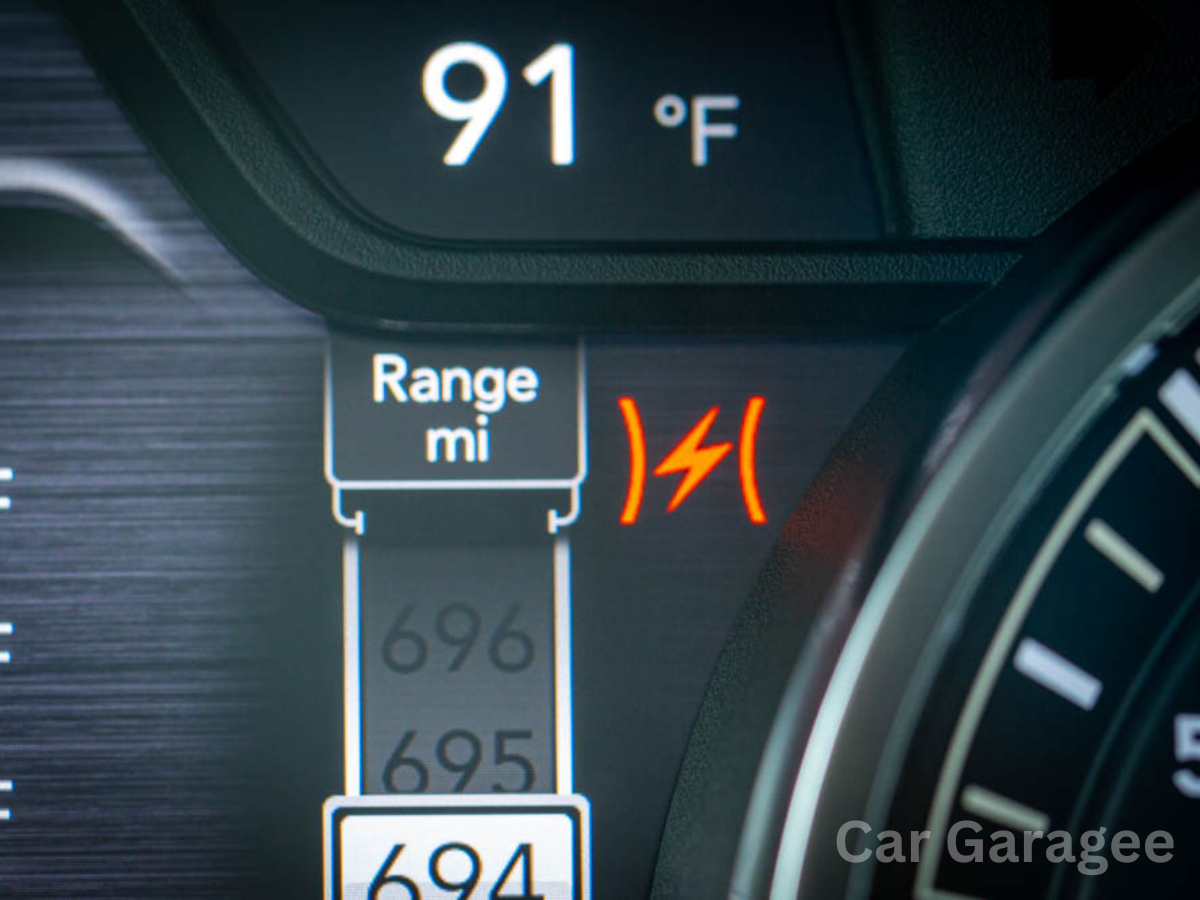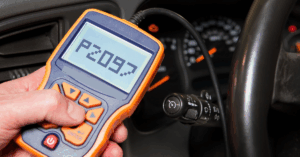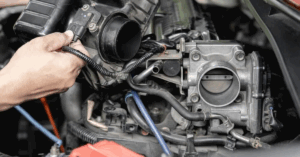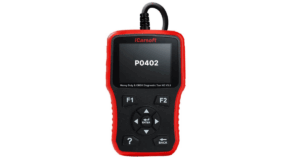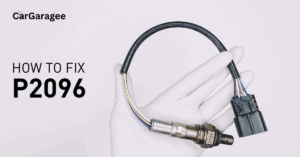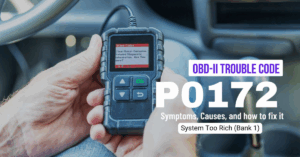If your car has a electronic throttle control light on the dash, it’s likely that your throttle control system has a problem. This electronic system connects the gas pedal to the throttle using signals, unlike older vehicles where the parts were physically attached. Vehicles over 30 years old had a more mechanical system, but newer models use computer-controlled systems with electronic components. If something goes wrong, you might see a lightning bolt symbol with reversed parentheses, or even a check engine light or wrench light, indicating an issue. When the warning light comes on, your vehicle might struggle to control the throttle, and ignoring it can lead to more serious problems.
Let’s take a brief look at how the throttle control system works. In gas-powered vehicles, the ETC uses sensors to send electrical signals from the throttle pedal to the engine, regulating the balance of fuel and air. This ensures proper throttle opening and closing, but if disrupted, it can lead to reduced engine power. In some cases, the system goes into limp mode, where the engine’s fuel and air intake are limited to prevent damage.
This is a sign that you need a mechanic’s attention immediately. When the ETC is malfunctioning, whether from coupling issues or sensor failure, it can cause your vehicle to behave unpredictably, especially during driving. If you see the light stay on or flash, it’s important to consult an auto mechanic who is familiar with electronic throttle systems to properly identify and resolve the issue before it worsens.
What Does the Electronic Throttle Control Light Mean?
The electronic throttle control light is an important indicator on your car’s dashboard that signals there may be an issue with the throttle control system. The ETC is responsible for throttle opening, ensuring the engine gets the right mix of air and fuel for smooth operation. Unlike older mechanical connections from the 20th century, today’s vehicles use electronic throttle systems controlled by computers, making them more reliable.
When a problem arises, such as a stuck throttle valve or a faulty throttle position sensor, this light will flash to alert drivers. These symptoms include reduced engine power, poor acceleration, and difficulty maintaining a consistent speed, which should be addressed by a qualified mechanic who can diagnose and repair the issue. Ignoring the warning could lead to further damage to important parts like the wiring and connections.
In the late 190s, the development of drive-by-wire technology replaced cable-based throttles with sensors and the engine control unit. This allowed more precise metering of the air-fuel mixture and exact control of the engine speed through signals from the gas pedal. When you press the accelerator, the system regulates airflow by controlling the internal butterfly valve and adjusting the engine’s timing. This ensures a balance between fuel economy and vehicle performance. However, if the system is interrupted or malfunctioning, it may lead to a safety hazard, putting the vehicle in limp mode to prevent further damage. This could result in an overall loss of engine power or slower speed.
If the electronic throttle control light comes on and flashes on the instrument panel, it’s a clear sign that something is wrong. This means the engine computer is limiting the cycle of ignition and timing to protect the engine. The ETC system is designed to be reliable, but if there is a problem with the programmed profiles or streamlined acceleration, it’s essential to have the car inspected. Issues such as a faulty cable-operated system or disrupted signals should be fixed immediately to avoid further complications.
Reasons for the Electronic Throttle Control Warning Light
Engine Control Module (ECM) Failure
One of the common reasons for the flashing electronic throttle control light is a failed engine control module (ECM). The ECM is responsible for controlling the ETC system. When it fails, it disrupts the function of the throttle control system, resulting in irregular throttle control operation. This problem is often hard to track down, but some symptoms include a car that accelerates irregularly or experiences a total loss of control. If this happens, you should pull off the road, shut off the engine, and get your vehicle towed to a certified repair shop for immediate repair work. A mechanic with extensive experience will be able to diagnose the problem using OBD-II error codes and take the correct repair action.
Throttle Controller and Wiring Problems
Issues with the throttle controller or the vehicle’s wiring can also cause the electronic throttle control light to turn on. A loose electrical wire, relay control, or damaged sensor can cause the system to lose signals. This can result in a failure to send electric signals to the engine, leading to poor acceleration and possibly a shutdown of the vehicle. It’s important to stop driving immediately and have the car towed to a servicing center for a thorough check-up. A mechanic will scan the engine computer for trouble codes to identify the source of the problem and replace any troublesome parts.
Throttle Hesitation and Major Safety Risks
Another cause for concern is throttle hesitation or a stumbling effect during acceleration. This is a result of erratic operation in the system, which can indicate damage to the throttle control. These issues pose major safety risks, especially if a stuck throttle occurs, which can lead to road accidents. In this case, you should engage a mechanic to inspect the system and perform any necessary repairs. The mechanic will check for signs of failure, such as wrong signals sent from the throttle controller. These signals can cause the engine to burn too much fuel or inject the wrong amount of air into the air-fuel mixture.
Fuel Economy Issues
A sudden drop in fuel economy, with frequent fill-ups of your tank, may also trigger the electronic throttle control light. This often happens because the engine receives wrong signals and burns more fuel than necessary. You may notice an abrupt drop in your vehicle’s mileage, which indicates that the air-fuel mixture is off-balance. If left unchecked, these fuel problems can cause further damage to the engine. A mechanic will use a digital scanner to find the associated trouble code and determine if the throttle controller needs to be repaired.
Limp Mode and Acceleration Issues
In some cases, the ETC system may enter limp mode, where the vehicle’s acceleration is limited to fast idle or low-speed driving to prevent damage to the engine. This happens during a serious failure or sensor failure, which causes the system to automatically reduce speed to protect critical components. The ECM will continue to impose these limits until the issue is addressed. If the damaged accelerator pedal position sensor is responsible, it may not be detecting the correct position of the pedal or transmitting the right information to the engine control module. These issues need to be diagnosed and fixed promptly.
Sensor Failures and Electromagnetic Interference
Finally, problems like sensor failure or electromagnetic interference can cause the ETC system to malfunction, triggering the flashing warning light. A mechanic will need to perform a thorough checking of the system, including the wiring, sensors, and any part of the throttle body that could be malfunctioning. By replacing or repairing parts, the system can be restored, and normal driving conditions can be resumed.
Symptoms of a Flashing Electronic Throttle Control Light
- Strange acceleration patterns: Your vehicle may hesitate, stumble, or struggle to accelerate smoothly. These are common signs that the ETC light is flashing, which could be an indication of damaged throttle control mechanisms. The electronic throttle control system relies on signals to maintain the car’s speed, but when these signals are wrong, it hinders the car’s ability to move efficiently. You may notice slow speeds or the inability to accelerate, leaving the car stuck at idle. This could lead to the ETC system malfunctions, and it is important to get the computer codes checked immediately to find the source of the problem. Ignoring these obvious symptoms could lead to engine damage or put the car into limp mode to prevent further damage.
- Rough idling and stalling: Your vehicle might be experiencing rough idling or even stalling unexpectedly. These symptoms occur when the engine is receiving an incorrect air/fuel mixture, possibly because of a malfunctioning throttle body or its related components. A throttle body reset might be necessary if you notice these signs along with an illuminated check engine light. If not addressed, this could cause additional damage to the engine and its internal parts. When the throttle body becomes contaminated, it affects the engine’s ability to get the proper amount of air, leading to poor acceleration and a significant drop in fuel economy. This is especially dangerous if it creates a safety hazard for drivers on the road.
- Plummeting gas mileage and fuel issues: If your car is guzzling a high amount of gas, it could be due to a damaged throttle controller sending wrong signals to the engine. This leads the engine to burn excessive fuel, resulting in frequent fill-ups and a plummeting gas mileage. The vehicle might feel like it’s struggling or lacks power. A contaminated or stuck throttle body might be the root cause, reducing fuel efficiency. In these cases, a mechanic should run diagnostic tests and, if needed, clean or repair the throttle to prevent further engine damage.
How To Fix Service Electronic Throttle Control
Step 1: Gather Necessary Tools and Materials
Before starting the reset process, gather all the necessary tools and materials. You will need a scanner tool depending on your vehicle’s make and model, a clean rag, and any specific tools as recommended by the manufacturer. Make sure to park the vehicle on a level surface and engage the parking brake to keep it stationary. Also, allow the engine to cool down after driving to avoid working on a hot engine, which can be dangerous and lead to injury.
Step 2: Turn Off Accessories and Disconnect the Battery
Turn off all accessories, including the air conditioning, radio, and headlights, to prevent the electrical system from becoming overloaded during the reset procedure. Locate the throttle body in your vehicle—typically near the air intake and attached to the intake manifold. Disconnect the negative battery cable from the battery terminal to begin the reset process. Use a towel or cardboard to ensure the negative battery cable terminal does not touch the negative battery post. This is a MUST to prevent the car battery from shorting out.
Step 3: Use a Jumper Wire for Draining Capacitors (If Required)
In some cases, using a jumper wire to connect the negative battery terminal to the positive battery terminal is required. Although this may seem like a BAD idea, it helps drain the capacitors in the onboard computer, effectively wiping stored throttle sensor values. After about two minutes, carefully remove the jumper wire—first disconnect the positive battery terminal, followed by the negative battery cable terminal.
Step 4: Clean the Throttle Body and Reconnect the Battery
Remove any protective covers from the throttle body assembly and inspect the air intake components. Use a clean cloth or brush to wipe away any dirt or debris from the throttle body and sensor surfaces. Reconnect the negative battery cable to the battery terminal, which allows the ECM to start relearning the correct idle settings.
Step 5: Recalibrate the Throttle Position Sensor
Follow the manufacturer’s guidelines or the service manual to recalibrate the throttle position sensor. This may involve resetting the sensor’s signal output to match the throttle plate position. Depending on your vehicle’s make and model, the process might include manually adjusting the sensor, using a scan tool, or cycling the ignition key. Ensure you follow the specific instructions carefully, pressing any specific buttons in the right sequence to complete the reset procedure.
Step 6: Complete the Reset and Calibration
Once the reset process is complete, reassemble any removed components and reconnect the negative battery terminal. Turn the key to the ON position and wait for the initial dash warning lights to turn off. Start the engine and let it idle for about 15 minutes. The ECM will use this time to relearn the correct idle settings, and you might notice slight fluctuations in idle speed as the system adjusts. In some cases, such as with a jeep, you may need to slowly depress the gas pedal to the floor and release it to complete the throttle calibration procedure. If you’re unsure, you can always google the calibration procedure for your specific vehicle, and it will likely pop up.
Can I drive with the throttle control light on?
When the throttle control warning light starts flashing on your car dashboard, it’s a key indication of a problem with your ETC system. This could cause your vehicle to either accelerate unpredictably or stop accelerating altogether, creating hazardous situations for you and your passengers. If your car is running erratically, it’s best to pull over to a safe location and have it towed to a repair shop.
Driving with a faulty ETC system can lead to further damage, and in some cases, the engine may enter limp mode, where engine power is reduced to prevent serious harm. It’s crucial to drive cautiously and at a reduced speed if you must continue, but the best advice is to get the vehicle inspected by a qualified mechanic for a thorough diagnosis and repair, ensuring your safety and preventing any further damage.
FAQS
How Do I Fix My Electronic Throttle Control Warning?
If you see the electronic throttle control warning, the first step is to inspect or replace the throttle body. Sometimes, you can disconnect the battery and then reconnect it to clear any faults, but this may only be a temporary solution. For a more permanent fix, you’ll need to perform a relearn calibration after replacing or servicing the throttle body. It’s always important to get the system inspected and possibly replaced by a professional if the problem persists.
What causes the electronic throttle to go bad?
One of the main causes of a malfunctioning throttle body is internal contamination. Over time, contamination builds up and accumulates, preventing the throttle valve from being able to move properly. This leads to problems with the control of the engine’s air supply, which directly affects how the throttle functions. When the valve cannot function smoothly, it impacts overall engine performance and can lead to more serious issues if not addressed.
What can damage a throttle body?
A dirty throttle body is often caused by grime and dirt build-up, which can disrupt the airflow and pressure needed for proper engine performance. When the throttle body becomes clogged, your car will likely experience uneven or slow acceleration because the engine struggles to generate enough power for combustion. If your vehicle takes longer to pick up speed, it’s a sign that the throttle body may be dirty and needs attention.
What controls the electronic throttle control?
The electronic throttle control (ETB) in your vehicle is managed by a small electric motor that opens and closes the throttle body plate. This entire process is handled by a computer that controls how your car’s engine responds. Depending on the vehicle you drive, this computer could be either the powertrain control module or a dedicated ETB module specifically designed to manage the throttle.
How do you fix an electronic throttle sensor?
The easiest way to fix an electronic throttle sensor is to reset the throttle position sensor. You can do this by unhooking the negative cable from the battery and waiting for about five minutes. After that, you can also remove the fuse for the engine control module to clear any stored data. Once done, reconnect the battery, and the system will be reset, allowing the sensor to recalibrate.

Mian Hashir is a passionate automotive enthusiast and the lead author at Car Garagee, a website dedicated to providing in-depth car reviews, maintenance tips, and the latest news in the automotive world. With years of experience in the industry, Hashir combines his technical knowledge with a love for cars to deliver insightful and engaging content. Whether you’re a car owner or a curious reader, Mian Hashir’s articles help readers make informed decisions, from choosing the right vehicle to understanding how to keep it in top condition.

